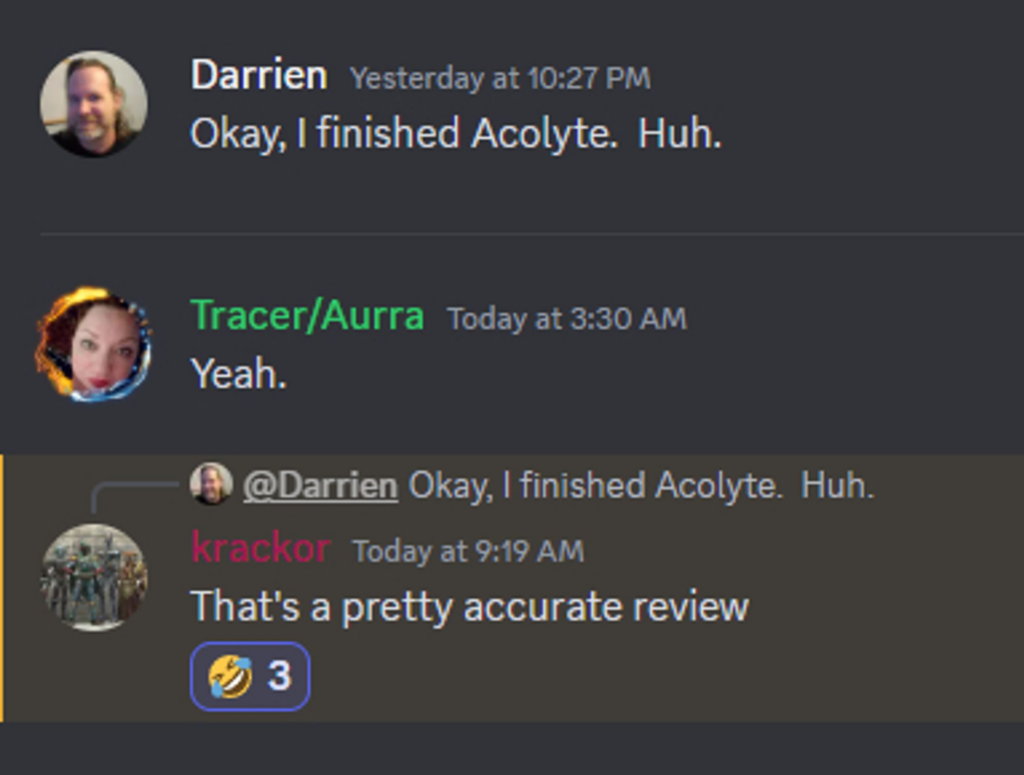Star Wars: Acolyte — A Review
Before I get to the review, let me talk about what’s going on with me and my writing.
It’s Sunday, almost afternoon, and I’m sitting in Pachamama’s coffee shop downtown. In a little while, there should be a Shut-up and Write here. I think my friend Mike Baltar will show up then. Unless he reads my blog beforehand, my appearance here today should be a surprise.
Yesterday, Melissa and I celebrated Bryanna’s birthday by taking Bryanna and her best friend for a ride. We went through the Jelly Belly Factory tour, something we haven’t done in ages. We spent some time in Benecia, sampling fancy oils, looking at art, eating tasty food, and sitting by the water in the bay. Once back home, we went to the Tower Cafe near downtown. We did our best to make Bryanna feel special, and I think we did a pretty good job.
While on the road, I had some time to think about the next Mel Walker novel. I’ve been a little bit stuck on part of the outline, so I haven’t drafted any of the new story yet. Yesterday, while I sat on the passenger side of the car with my laptop open and my mind focused, I did some free indirect writing and realized that my current outline is probably enough. I’ll revisit it once I get going, but Mel Walker stories rely on my wit in the moment of discovery.
I did not outline The Repossessed Ghost, and I had a very short outline for The Psychic on the Jury. Why do I think I need a broader plan for The Psychic Out of Time?
The next Mel Walker novel is more complicated than the previous stories, no doubt about it. But I already figured out the complicated parts. My outline describes a coherent story. It’s just missing a handful of details, which I’m certain to figure out after I’ve started, and not before.
So, it’s time to start.
Before I begin drafting, I want to talk about The Acolyte since we just received news that there will be no season 2, and I think some people (probably Disney) will walk away with the wrong lesson from the first season.
I sort of wrote a short review once already. It looked like this:

I can go deeper, though, so I will. Let this be your spoiler warning. Hereafter, I will dive into the details of Star Wars: The Acolyte – Season 1. If you haven’t seen it yet and you want to watch it without spoilers, now is the time to bail out on this post.
Let’s talk about some of the things I liked, and some of the things that are quintessentially Star Wars.
- Some fun lightsaber stuff
- Twins are a common Star Wars trope, which works about half the time
- The show looked good, and the scenes on Coruscant were consistent with what we’ve seen of that planet in other movies and shows
- Good choreography
- Good ship designs
There are other good things, but this list feels safe. If you tell someone else that watched the show that you liked those things, they would probably nod in begrudging agreement.
I personally like that they visited new places in the galaxy. No time or mention was made of Tatooine. The new places reminded me places we’ve seen before in the Star Wars galaxy, but that’s fine. There should be multiple forest planets and moons beyond Kashyyyk and Endor.
I like that we got to see Force users that weren’t just Jedi and Sith. The Force is mystical, powerful, and everywhere. There should be other people with connections to it that are different and interesting.
Now let’s talk about some of the things that didn’t work for me.
Starting with some minor, arguable points, I think the Jedi should be good guys. In this story, they… weren’t. Should they be perfect? No. Can their arrogance lead to them making mistakes? Absolutely. How about invading a family’s house, murdering everyone inside, and then covering it up for years and years? No. No, that’s a bridge too far.
To write a good story about the Jedi, it is best to treat them like Superman. There are deconstructions of Superman where they take away or reduce his morality, but then you’re not dealing with Superman anymore. I think the same can be said for the Jedi. Unlike Superman, villains can overpower a Jedi, but the Jedi should continue fighting the good fight with The Force as their guide. They can be corrupted and fall, but then they’re not Jedi anymore.
Does that mean that I did not like the antagonist, Qimir? No. Qimir was a Jedi, but then he “fell” and became something else. He said the Jedi would call him a Sith, but I don’t think Qimir was a Sith, either. He was something different, not entirely evil, but definitely not a good guy. There was a kind of fairness to him which made him a more compelling character.
So far, I’ve talked about minor things. I have a great capacity for forgiveness for most things Star Wars, and everything I’ve mentioned so far, I could handwave away, if necessary.
Not this next point, though. Let’s talk about our main characters, and the real failing: Mae and Osha.
We start with Mae tracking down Indara in a weird bar and trying to kill her. Indara is a Jedi Master, but Mae holds her own for the most part. The choreography is good. I enjoyed the action. Then, at the end of the fight, Mae gets the better of Indara by throwing a blade at the bartender, an innocent bystander. Indara, acting as a hero, changes her focus to save the bartender, and then Mae uses the distraction to kill Indara, a true act of villainy.
After this, we’re introduced to Osha, who seems like a nice person. We’re given an extremely minor mystery in the form of, “what’s up with Osha and did she kill those people in the bar?” The mystery is resolved very quickly, which leaves us with twins: one that has done an unforgiveable act in the process of murdering Indara, and one that we want to see reunited with her master so that she can continue learning the Force and become the Jedi she once wished to be.
This is a fine setup. There’s nothing wrong with this. But then, through the course of the show, we’re shown more of Mae and Osha. The story tries to make us like Mae more, but she’s already demonstrated that she’s willing to kill innocent people to achieve her goal. If she hadn’t tried to kill the bartender in order to kill Indara, I might have been able to get on board with her redemption. She was, after all, going after “bad” Jedi, right? The people that were responsible for the death of her family and stranding her alone all those years ago, right?
Then Osha kills Sol and goes off with Qimir. She turned to the dark side, corrupting the crystal in her old Master’s lightsaber. This leaves us with zero characters to root for and care about.
That is what went wrong with Star Wars: The Acolyte. We had no hero.
In the original trilogy, we love Luke, Han, and Leia. We will go to the ends of the galaxy with them and back. They are heroes, and we love them.
In the prequel trilogy, we love Quigon until he dies. We are on board with Anakin, until he becomes Darth Vader and kills Jedi children. We love Obiwan, but he’s not really given that much screen time. And we mostly love Padme, until she disappears in the third movie, showing up at the end to die giving birth to our next set of heroes.
I’m not going to talk about the sequel trilogy at this time.
The point that I’m trying to make is that Star Wars is best when we have a character to root for. It’s best when we have someone to get invested in.
The Mandalorian series has been good because we like Din Djarin. He’s a hero, and we can follow him around and enjoy his stoic heroism.
We didn’t get a hero in The Acolyte that we could latch onto and root for. That’s the biggest failing of the series, and the lesson Disney will fail to learn. Other Star Wars fans may air other grievances, but I think everything else could have been forgiven if we’d just been given one character to love without reservation.
That’s my extended review of The Acolyte. It wasn’t worse than The Rise of Skywalker, in my opinion, but I understand why people didn’t like it.

